Homemade Tahini Recipe
This post may contain affiliate links. See my disclosure policy.
This easy homemade tahini recipe is so quick to make, takes just TWO ingredients, is less expensive than store-bought, and tastes WAY better! Make a double batch while you’re at it and store it in your fridge for several months to have on hand whenever you need it!
Use it make the best creamy Hummus Recipe or drizzle it over your homemade Falafel!
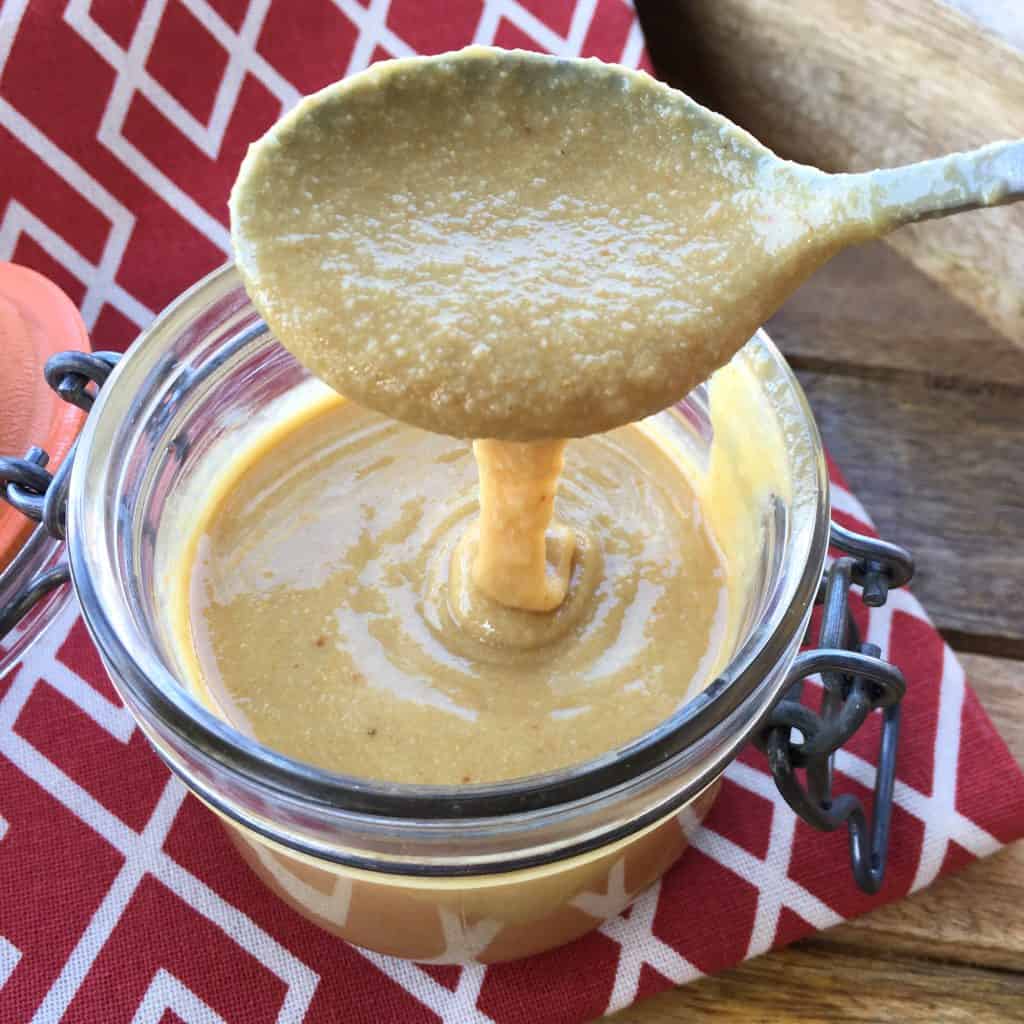
The scenario you may be familiar with: You’re really in the mood for some homemade hummus. Garbanzo beans? Check. Olive oil? Check. Lemons? Check. Garlic? Check. Tahini paste? Aw, dang it. Well don’t let that stop you again. Tahini is not only super simple to make, but homemade is cheaper than store-bought and it tastes better!
What is Tahini?
Tahini is a Middle Eastern condiment that is made from hulled sesame seeds that are toasted and then ground into a paste. It’s a popular staple in Middle Eastern, Greek, and East Asian cooking. It is served by itself as a condiment but also incorporated into a very wide variety of dishes, most famously a central ingredient in hummus.
Tahini Ingredients
To make tahini you only need two ingredients:
- Sesame seeds
- Olive Oil
You may be asking, “why do you need olive oil for tahini?” and that’s a good question because if you look at the ingredients of most commercially-sold tahini, it does not include olive oil. But there’s a good reason why homemade tahini needs the addition of olive oil and that’s because the oil from the sesame seeds cannot be fully extracted without specialized commercial equipment. If you put a bunch of sesame seeds in a regular blender you will get a heap dry ground sesame seeds. Another factor has to do with the freshness of the sesame seeds (the fresher the more oil) and unfortunately most of the sesame seeds available at the store have been sitting there, and in warehouses before that, for a long time. And so we add olive oil.
Shopping Tip: Buy sesame seeds in bulk. Buying the in tiny bags or cans with just a few ounces is expensive and they’re a better deal in bulk. You can buy sesame seeds in the bulk sections of some grocery stores or you can buy them online such as here.
Pro Tips
- Use hulled sesame seeds. Hulled sesame seeds have had their hard outer shell removed which 1) makes the tahini smoother and 2) less bitter tasting.
- Be careful toasting the sesame seeds. As soon as the sesame seeds start changing color watch very closely because they can scorch quickly which will make them bitter. Toast just until they’re golden.
- Use a high quality olive oil.
- Use a high-powered food processor or blender. A food processor like my mini-prep Cuisinart food processor (we’ve had ours for 17 years and it’s still going strong) does a good job and is ideal for smaller quantities like this but for a smoother tahini paste you can use a high-powered blender such as my Vitamix 5200 (we’ve been using it on average twice a day, every day, for the last 15 years and it’s a total workhorse).
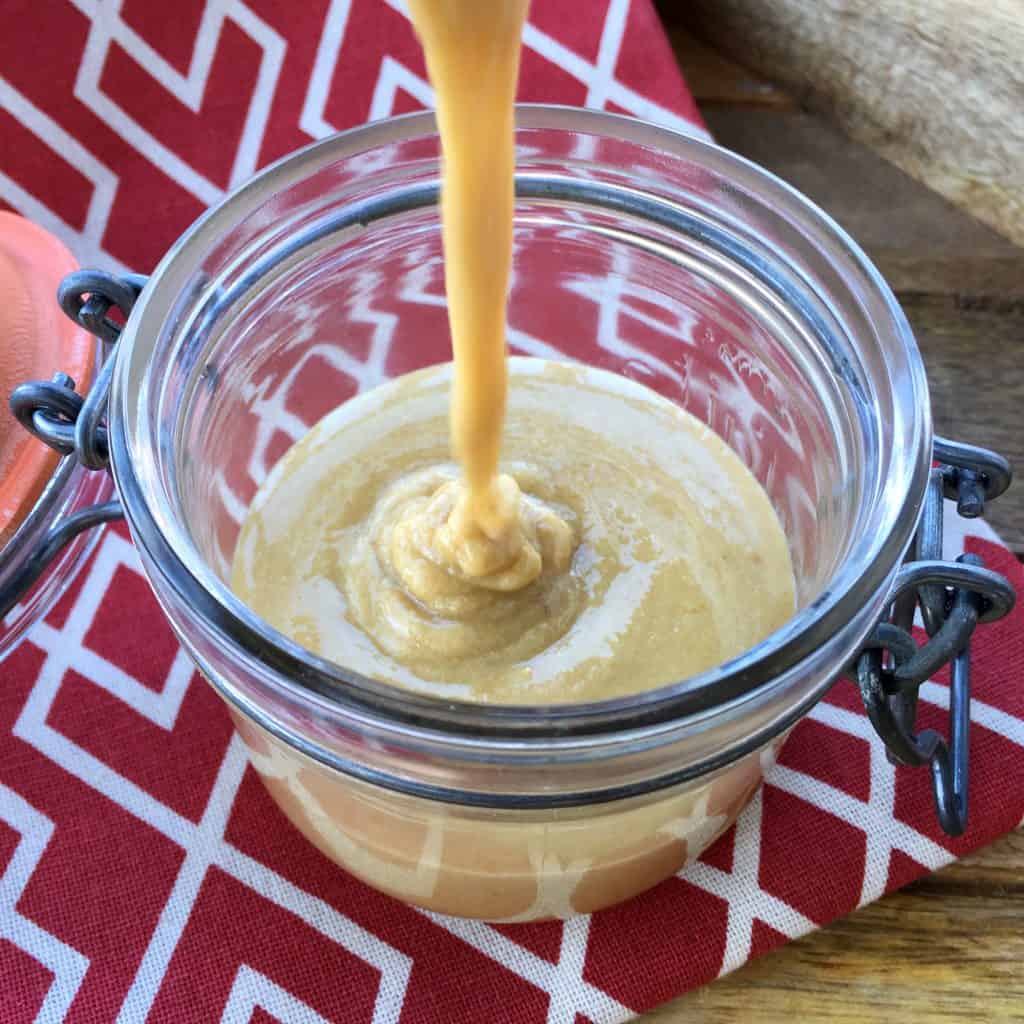
Tahini Recipe
This tahini recipe uses one cup of sesame seeds which will make about 3/4 cup tahini paste, depending on how much olive oil you use. How much olive oil you use will depend on how thick you want the paste. You’ll need at least 3 tablespoons of olive oil and possibly up to 1/3 cup. Note: If you’re using a high-powered blender like a Vitamix, you may need less oil than if you’re using a food processor.
Let’s get started!
Heat a clean, dry cast iron or heavy duty skillet over medium high heat and add the sesame seeds. Stir frequently until they begin to turn golden brown and then stir constantly. Be careful, sesame seeds burn very easily.
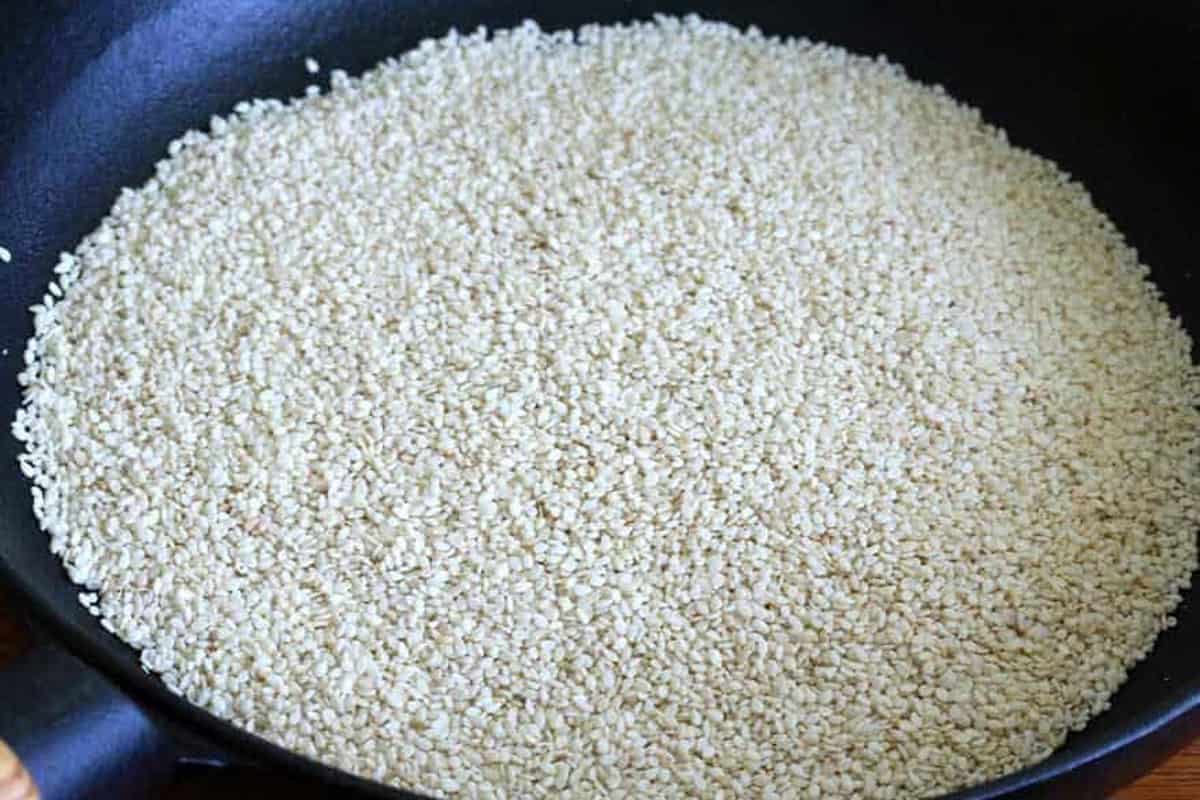
You definitely don’t want burnt sesame seeds (they taste awful!), but you do want them generously golden brown for optimal flavor.

Once they’re toasted, let them cool a few minutes then add them to a food processor. I use and love Cuisinart’s mini prep food processor. With a 3-cup capacity it’s perfect for smaller jobs like this. We’ve had ours for over 15 years and it’s still going strong!

Start by adding 3 tablespoons of olive oil. Process the mixture into a paste, scraping down the sides. Add more olive oil until you reach the desired consistency. If you’re using it to make hummus, the paste should be fairly thickly “pourable” (like in the main recipe picture above).
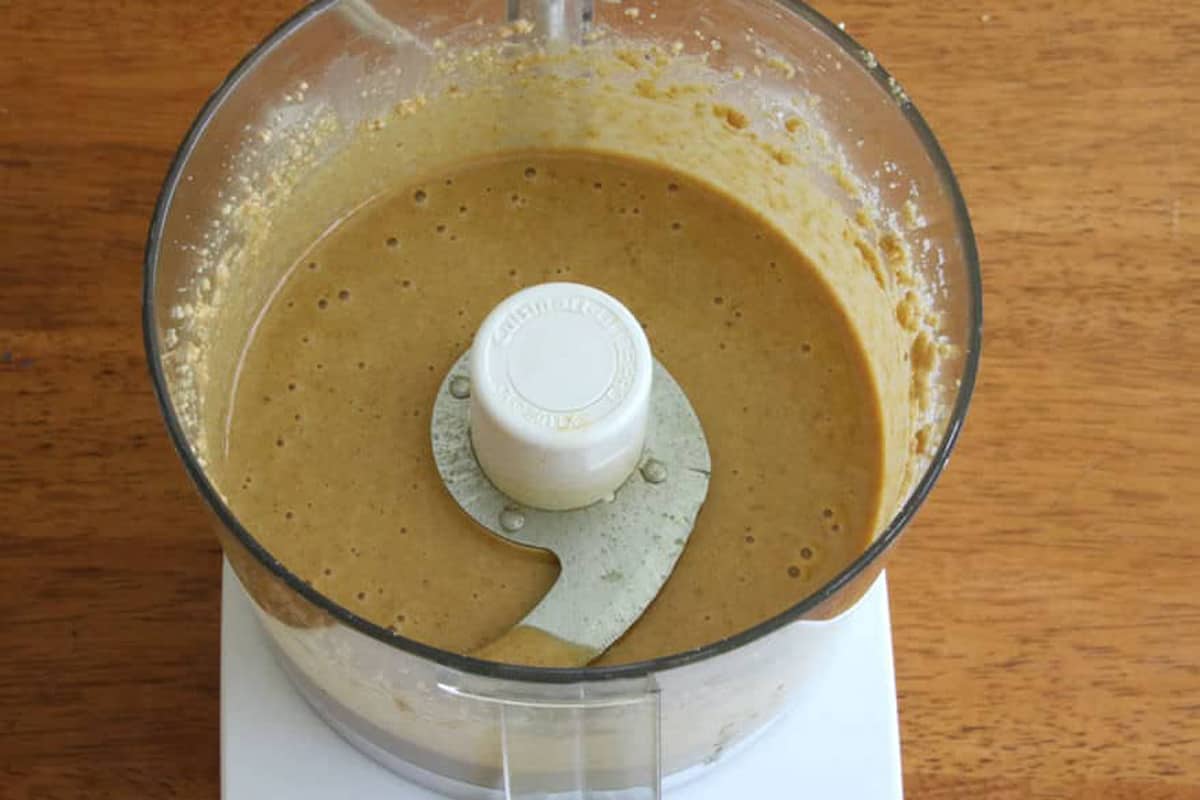
Storage & Freezing
Stored in the fridge in an airtight jar, tahini will keep for 1-2 months; potentially longer but for optimal freshness use it within that time frame. The oil will separate during storage, which is completely normal. Just give it a good stir before using.
Tahini can also be frozen for up to 3-4 months. You can freeze it in its jar, leaving some headspace because it may expand a little. For convenient smaller portions you can also divide it up in ice cube trays, freeze it, then put the frozen cubes in a freezer bag or container, and just take out what you need. Either way, let the tahini thaw slowly, ideally in the fridge overnight.

How To Use Taxhini
There are a number of delicious ways you can put your homemade to use. Here are just a few ideas:
- Hummus – its most popular use, check out our phenomenal Hummus Recipe.
- Baba Ganoush – like hummus, it’s wonderfully creamy and the tahini is a central star of the show.
- Tahin Pekmez – a popular dip in Turkey. It has the reputation as being the Turkish PBJ because it’s made with tahini (which has kind of a peanut-buttery taste) and grape molasses. Sound like a winning combination? It is!
- In Greece it’s a popular condiment in which to dip pita and souvlaki (grilled meat kabobs).
- In Israel it’s a staple topping for Falafel and shawarma. It’s also used to make halva-like treats.
- In East Asia it’s commonly used in noodle dishes.
- Throughout the Middle East it is used in sauces for meats and vegetables to enhance the flavor.
- It makes a really nice tahini salad dressing combined with lemon juice, olive oil, honey or maple syrup, garlic and salt.
- Drizzle it over your sandwiches, wraps, and lettuce wraps.
- Drizzle it over grilled meats and vegetables. It’s amazing on our Grilled Eggplant!
- Add it to your baked goods like cookies for a delicious twist!
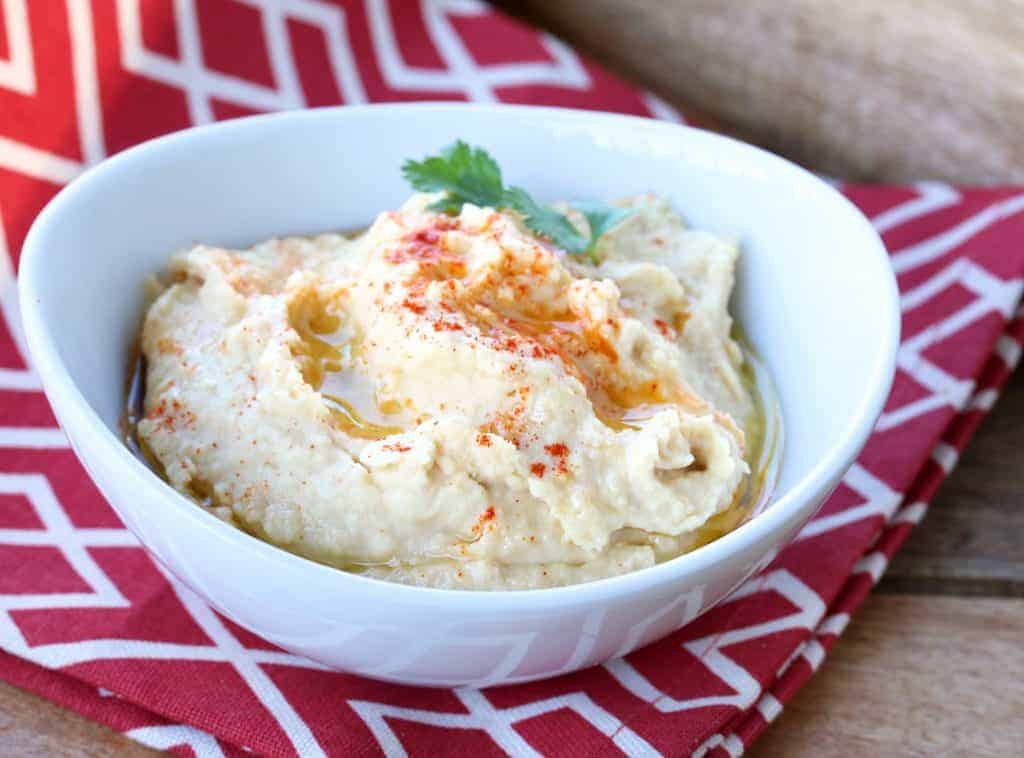
For more delicious homemade condiments try my:
- Tartar Sauce
- Yum Yum Sauce
- Bearnaise Sauce
- Black Bean Sauce
- Hoisin Sauce
- Big Mac Sauce
- Jerk Sauce
- Adobo Sauce
- Mignonette Sauce
- Aji Verde
- Enchilada Sauce
- Homemade Ketchup
- Ponzu Sauce
- Char Siu Sauce
- Romesco Sauce
- Eel Sauce
- Sweet Chili Sauce
- Remoulade
- Teriyaki Sauce
- Sweet and Sour Sauce
Save This Recipe
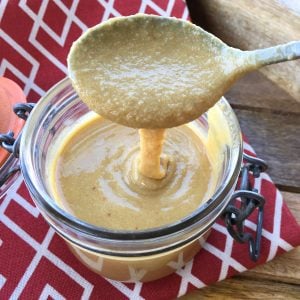
Homemade Tahini Recipe
Ingredients
- 1 cup hulled sesame seeds
- 3 tablespoons or more extra virgin olive oil ,see Note (see also blog post about why olive oil is added)
Instructions
- Heat a clean, dry cast iron or heavy duty skillet over medium high heat and add the sesame seeds. Stir frequently until they begin to turn golden brown and then stir constantly. Be careful, sesame seeds burn very easily.
- Once they're toasted, let them cool a few minutes then add them to a food processor. Start by adding 3 tablespoons of olive oil. Process the mixture into a paste, scraping down the sides. Add more olive oil until you reach the desired consistency (*see Note)
- Store the tahini in an airtight jar in the fridge and it will last for several months. Stir it throughly before you put it in the fridge because once it's chilled it's difficult to stir. This makes a little less than 3/4 cup tahini paste, depending on how much olive oil you use.
Notes
Nutrition
Originally published on The Daring Gourmet May 2017



















Hello Ms. Kimberly,
I enjoy hummus and am trying to find recipes that I can make. Upon stumbling this article, I have to say this. This looks and sounds amazing; however, I have an extremely small food processor, no blender, no hand blender (I do have a hand mixer and a whisk), or any other way I can think of to make this or the hummus. My food processor will hold maybe 1 cup of product. I also do not have a cast iron skillet, or a heavy duty one either. Neither can I afford to go buy said products. If I toast my sesame seeds in a small copper skillet and process them in my overly small processor by cutting the recipe in half, do you think this would work out fine?
Hi Kris, that’s no problem at all. Absolutely, you can toast the sesame seeds in your copper skillet. Just watch them very closely towards the end, they burn very easily and very quickly! With your food processor, yes, you can either halve or quarter the recipe, or I would simply process the ingredients in batches, a bit at a time, however much your food processor can hold. Then dump the processed hummus in a big bowl and give it a good stir to make sure everything is equally distributed and you’re good to go.
I’m so glad I found this! I have finally made the choice to live healthy and make my own food. I am so excited about it, I even bough a vitamix. I can’t wait to make hummus!! Since I don’t have a food processor my question is, can I make it in a vitamix and still get the consistency i need to make hummu
Hi Jeanna, I’m so glad you found us too – welcome! You’re going to love your Vitamix. I seriously couldn’t live without mine. Absolutely yes, you can make this in your Vitamix, in fact you’ll get even better results using it. The only thing is that you’ll need to double this recipe because if you make a smaller quantity like this it won’t process properly in the Vitamix. That’s the problem I’ve encountered when I’ve tried making really small batches of things in my Vitamix. That’s not really a problem though if you’re going to make hummus regularly, plus tahini lasts quite a long time.
Just a quick comment on peanut oil, it is healthy and not to be avoided, as nuts help reduce LDL cholesterol. I will be making the tahini as I make my own Humus so it would be good to do everything from scratch. I have even grown some chickpeas, but I don’t really have the climate for them. Also I make my own peanut butter so I can control the salt and not add any sugar. It’s very similar to making tahini.
Hi David, peanut oil’s only a problem if it’s used for high heat cooking because it’s too high in omega-6’s. Here’s a comprehensive guide on cooking oils we’ve published here and it gives the fatty acid breakdown of each: http://www.daringgourmet.com/2015/02/13/a-comprehensive-guide-to-cooking-oils-the-good-the-bad-and-the-ugly/. Agreed, homemade tahini and hummus is the best – no comparison!
Many thanks, Kimberly.
Hi there,
I am glad I saw this website. I had no idea that tahini can be made this way. My question, which may surprise you, is: would you have the proportional measures for making tahini in bulk form? Like by the gallon? Or is it more economical to just buy it?
Thanks much,
Emile
Hi Emile, it’s cheaper to make it yourself, no matter the quantity. This recipe makes roughly 3/4 cup and there are 16 cups in a gallon so you’d simply need to multiply it that many times.
Thanks much, Kimberly. The reason I asked is because some recipes should be multiplied by two or more. I am glad I asked.
Cheers,
Emile
Thank you so much for the Tahini recipe. I used it to make hummus! And it came out wonderful! Will be using it in my blog.
Thanks, Swati, I’m so glad you liked it! If you publish the recipe on your blog I’d really appreciate a link back to my site page. Thanks again for the feedback!
Ofcourse! Done already :)
I found your recipe while searching the internet because I didn’t have any tahini on hand and didn’t want to make a run to the store. It worked like a charm. I’m not buying it anymore, this was quick and easy. Glad I found your recipe, will be making it from now on, thanks.
That’s awesome, Chris, thank you!
I’ve made this tahini paste twice already and it is fabulous. Will never buy the stuff in the store again. Thanks for a great recipe and step-by-step instructions.